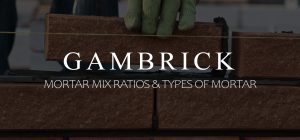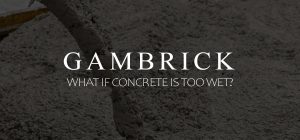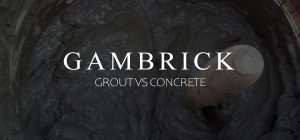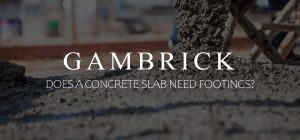
The Best Concrete Mix Ratio
The best all around concrete mix ratio for almost all residential work is 3500 psi. The concrete mix ratio to create 3500 psi concrete is 1:2.5:3. This means 1 part cement, 2 parts sand and 3 parts stone. Different strength concrete mixes have different ratios. I recommend using Portland cement, but any brand cement will work. The sand can be either fine or coarse. Coarse makes stronger, grittier concrete. Fine is easier to work with and creates a smoother surface. Stone aggregate should be about 1/2″ to 1″ and smooth.
Once you’ve mixed your ingredients into a dry concrete power, mix it with water to make concrete. I’ve been a mason for over 25 years, and can tell you firsthand that the mix ratio and how you mix your concrete are both very important if you want to make strong concrete.
Concrete is very strong, durable, long lasting and surprisingly affordable if you make and mix it correctly. Masons have been using concrete for centuries to build some of the greatest structures ever built.
It’s made of 3 main dry ingredients: cement, sand and stone. These 3 ingredients are mixed together to form dry concrete, which is what you find in a bag of Quikrete. When water is added to the mix, it reacts with cement to form a paste that eventually hardens. As concrete dries it grows stronger which is called curing.
The strength of concrete is measured in p.s.i. or pounds per square inch. Adjusting the mix ratio, water level, or the ingredients used can alter the strength, looks, and workability of your concrete.
Altering the mix ratio and ingredients can also change the concrete’s attributes. For example, the ratio used to make foundational concrete is different than concrete for a fireplace or cast concrete statue.
How Concrete Is Made
Concrete is simply a mixture of cement, stone and sand mixed with water. When the cement is mixed with water it forms a paste that coats the surface of the sand and stone. Cement is the glue that binds ingredients together.
Through a chemical reaction called hydration, the cement paste hardens and gains strength which eventually forms a rock like substance called concrete.
Making concrete is a chemical reaction that transforms unrelated ingredients into a brand new material. When concrete is wet, it’s malleable and able to fit into just about any form. Then it hardens to retain the shape of whatever form it was poured into. This is what gives concrete such high versatility.
As concrete is hardening you can work it with trowels and floats. It becomes like a clay that can be shaped and formed by hand.
These qualities are why concrete can build everything from skyscrapers, bridges, and superhighways to cast statues and countertops.
Ratios
Another way of saying ratios is proportioning. This is a very important concept to understand when making concrete.
Concrete is made by mixing 3 dry ingredients with water to form a brand new material. The key to achieving a strong, durable concrete relies on carefully mixing the ingredients in the correct ratios. Think of it like baking a cake and following a recipe. The ingredients needed to bake a cake come together during the baking process to create something new. If you use too much sugar, butter or flour, the cake won’t come out right.
A mixture that doesn’t have enough cement to fill all the voids between aggregates will be hard to work with and difficult to smooth. The result will be weaker and less attractive concrete. However, a mixture with too much cement will be easier to work with and smoother. But it’ll be weaker.
Water isn’t one of the dry ingredients but it’s still essential. When you mix dry concrete with water, the cement chemically reacts to form a paste. The quality and strength of the cement paste relies on using the correct amount of clean fresh water.
Just like dry ingredients, the amount of water you use is important for creating strong and durable concrete.
A properly mixed concrete will have good workability with high strength and durability.
Concrete Mix Ratio Ingredients
No matter what strength concrete you need, or what concrete mix ratio you use, the same basic ingredients are required to make concrete. Cement, sand and stone. Those are the 3 primary ingredients used to make every concrete mix.
When you buy a bag of Quikrete or Sakrete premixed concrete, what’s primarily in the bag is cement, sand and stone.
Some specialty mixes may also include additives that give the concrete special properties like more strength or faster set times. However, these additives aren’t required to make concrete.
But what kind of cement, sand and stone do you need. Just knowing the ratio of ingredients isn’t enough. You also need to buy the correct type of cement, sand and stone.
When you look at a concrete mix ratio, it’s always in the form of 3 numbers. For example 1:2:3. The first number is always cement. The second number is always sand. And the third number is always stone.
In this section we’ll go over each ingredient with some tips on what to buy.
Cement
Cement is an adhesive that starts off as a powder. It becomes a sticky paste when mixed with water. Cement’s primary ingredient is calcium oxide which is a product of super-heated limestone. It also contains silicon, aluminum, iron, and a variety of other secondary ingredients.
Cement is the active ingredient in concrete that binds stone and sand together. It’s essentially the glue that makes concrete what it is. Sand makes concrete gritty. Stone makes it strong. But cement makes it stick.
While cement is very hard all on its own, its strength is nowhere near concrete’s. Sand and stone greatly enhance cements strength. It’s only when all 3 ingredients are combined in the correct ratio that you get the full benefit of concrete. In this sense, concrete is a true hybrid material. Much better and stronger than the sum of its parts.
Cement is the reason concrete has weak tensile strength and requires rebar. Twisting forces can easily break concrete because cement is brittle with very low tensile strength. But by adding rebar or wire mesh, this weakness can be overcome.
More cement in a mix does not mean greater compressive strength. Rather, it actually means better adhesion and less strength. For more strength you must increase the stone ratio, not the cement.
I recommend buying Portland cement. Other brands or cement will work too but Portland is a very consistent and reliable product.
Sand
Sand is a filler that eliminates spaces between the stones. It has a high compressive strength and a gritty texture. Including sand in a concrete mix makes it stronger and changes it’s texture.
There are two main types of sand you can use to make concrete. Masons sand which is coarse and fine sand.
Coarse sand make stronger concrete with a rougher texture. Fine sand make concrete a little weaker but with a smoother, finer finish.
The type of finish you need should dictate which sand you use. For example, if I’m pouring footings that require strong concrete but won’t be seen, I use coarse masons sand. However, if I’m pouring a stamped concrete patio that needs a smooth finish, I use fine sand.
Stone
Stone aggregate is the primary ingredient that gives concrete it’s extremely high compressive strength. That’s a fancy way of saying it can support a lot of weight without cracking.
For example, a concrete mix ratio that produces 3500 psi concrete can support 3500 pounds per square inch without cracking. That’s roughly the weight of a small car on every inch of the slab.
You should use washed, crushed rock around 1/2″ to 1 ” in size. I usually order 3/4″ rock which comes in a variety of sizes all around 3/4″. The stones won’t all come the exact same size.
Concrete rock is often called gravel but it isn’t. When you call and order stones for making concrete, let the supplier know the rock is for concrete.
Concrete rock is smooth, rounded and washed clean. Gravel is rougher and dirty.
Don’t use unwashed stones to make concrete if you can help it. Any impurities in the dirt will effect the concrete’s strength and durability.
Concrete has extremely high compressive strength. Rocks and sand bound together by cement can support a lot of weight without cracking.
Water
Water isn’t a part of the concrete mix ratio, but it’s still an important ingredient worth mentioning. Because you can’t make concrete without it.
Water is what activates the cement which creates the chemical change that turns cement into a paste. Cement goes through a chemical process which forms a strong crystalline structure inside the concrete. That structure is what binds the stone and sand together. As the concrete dries it hardens and grows stronger. This process is called curing. Without water, concrete wouldn’t be possible.
Just like the other ingredients used to make concrete, you need the right ratio of water to dry mix.
I recommend adding water slowly into the mix until all the dry ingredients are moist. You need just enough water to activate all the cement and not a drop more.
The consistency should be like thick oatmeal. If the mix is watery you need more dry mix. If it’s powdery you need more water.
Water is what activates cement and controls the consistency of wet concrete. It’s essential that you use the correct amount of water when mixing concrete.
Use only fresh cool water. If it’s drinkable then it’s OK to use for making concrete. Do not use salt water. Salt will break down and weaken the concrete.
Never over water concrete. Too much water thins out the cement which weakens the bonds that holds the concrete together. Think of it like adding water to glue. Glue won’t be as strong if you’ve watered it down.
What’s The Best Concrete Mix Ratio?
When making your own concrete, it’s important to use the correct concrete mixing ratio for the strength you want to produce.
No matter which ratio you use, the ingredients are always the same. All you’re doing is adjusting how much sand, stone and cement you use in relation to the other ingredients.
The best concrete mix ratio for residential projects is 1:2.5:3. Which is 1 part cement, 2 1/2 parts sand and 3 parts stone. This mix ratio produces 3500 psi concrete which is strong enough for most footings, sidewalks, foundations, patios, floors and driveways. And it’s also workable enough to create a smooth patio or countertop surface.
3500 PSI concrete is the standard mix masons use for just about everything. From this mix, they can adjust the cement, sand and stone ratios to create weaker or stronger concrete. The typical range is 3000 to 5000 psi.
Additives can also be used to give the concrete special attributes like more strength, faster set times and flexibility. I’ll go over additives in another post.
To make 3500 psi concrete you’ll need four basic materials:
- Cement: I recommend using Portland brand but any cement will do
- Sand: Coarse sand creates stringer concrete but fine sand gives you a smoother finish.
- Aggregate Stone: I use 1/2″ to 1″ smooth washed stone.
- Water: Use fresh cool water. If it’s safe enough to drink then it’s good for making concrete.
How To Create The Concrete Mix Ratio
Now that you’ve got your 1:2.5:3 concrete mix ratio and all your ingredients are delivered and on site, it’s time to make the dry mix.
Turning raw ingredients into a dry concrete mix requires some measuring. The unit of measure you use doesn’t actually matter, all that matters are the ratios.
Most masons I know measure the ingredients using a flat head shovel. For a 1:2.5:3 ratio 3500 psi concrete, they add 1 shovel full of cement, 2 1/2 shovels of sand and 3 shovels of stone. They shovel the ingredients into a cement mixer, wheel barrow or tray and mix it up dry. Once the ingredients are thoroughly mixed, water can be added to create concrete.
The shovel method is what almost all masons use, but it’s not the most accurate. It takes a lot of experience. A good mason can tell by eye and touch if the concrete is right. If you’re less experienced try using buckets.
Another great way to measure dry concrete ingredients is with a 5 gallon bucket. To create the 1:2.5:3 concrete mix ratio, add 1 bucket of cement, 2 1/2 buckets of sand and 3 buckets of stone. Throw the ingredients into a mixer, tray or wheel barrow and start mixing.
Using buckets is a much more accurate way to measure out the concrete’s ingredients. However, it takes a lot more time and labor. This is why most masons use a shovel.
Adjusting The Concrete Mix Ratio
Adjusting the strength of a concrete mix is very easy. All you have to do is change the amount of sand you use in the mix. Changing the sand effects the overall concrete mix ratio.
The typical strength range for concrete you can make yourself is between 3000 and 5000 psi.
Altering the amount of sand you use essentially adds or reduces the amount of stone and cement in the mix. Cement is always 1 part and stone is always 3 parts. By changing the sand level you change the concrete’s strength.
Check out the concrete mix ratios we’ve listed below for the most commonly used concrete strengths.
- 3000 psi concrete has a concrete mix ratio of 1 : 3 : 3. 1 Part cement, 3 parts sand and 3 parts stone.
- 3500 psi concrete has a concrete mix ratio of 1 : 2.5 : 3. 1 Part cement, 2 1/2 parts sand and 3 parts stone.
- 4000 psi concrete has a concrete mix ratio of 1 : 2 : 3. 1 Part cement, 2 part sand and 3 parts stone.
- 4500 psi concrete has a concrete mix ratio of 1 : 1.5 : 3. 1 Part cement, 1 1/2 parts sand and 3 parts stone.
Remember, the ingredients are exactly the same no matter what strength concrete you mix. All you’re doing is adjusting the amount of sand you use. Changing the sand level changes the concrete mix ratio which then changes the concrete’s strength.
What’s The Best Concrete Mix Ratio For A Slab?
A slab of concrete is a flat section of concrete. A driveway, sidewalk, countertop or patio are all examples of a concrete slab. However, not all slabs are created equal.
Some slabs, such as a driveway, may require stronger concrete because it can bear more weight without cracking. While other slabs, like a patio, only have to support foot traffic and furniture. Patios can usually be poured with a weaker concrete.
In general, the best concrete mix ratio for slabs is 3500 psi or 1 : 2.5: 3. 1 Part cement, 2 1/2 parts sand and 3 parts stone.
This mixing ratio is excellent for just about any type of slab including a shed floor, patio, driveway, steps or a sidewalk.
If the slab requires more strength, I generally add rebar, wire mesh or make the slab thicker. I very rarely alter the mix ratio unless the plans specifically call for a higher, or lower, strength concrete.
Unless a plan calls for a specific psi concrete, I almost always use 3500 psi. However, if it does call for a different ratio, all I do is raise or lower the amount of sand I use. Check out the ratios I listed above for the most popular concrete strengths.
How Do You Calculate A Smaller Concrete Mix Ratio?
The great thing about using ratios to make your concrete is that the batch size doesn’t matter. You can mix 10 yards or 1/4 yard, as long as the ratios stay the same the concrete will come out strong and durable.
For small batches I simply use a smaller measuring bucket. Instead of a 5 gallon bucket I use a 2 gallon paint bucket. For a 3500 psi 1 : 2.5 : 3 mix ratio, I use 1 x 2 gallon bucket of cement, 2 1/2 x 2 gallon buckets of sand and 3 x 2 gallon buckets of stone.
If you need even less concrete, use a smaller bucket.
As long as you keep the ratios the same, it doesn’t matter how big or small each ingredient part is.
What Is The Strongest Concrete Mix Ratio?
The strongest concrete mix ratio you can make at home is 5000 psi 1:1:3. 1 Part cement, 1 part sand and 3 parts stone.
5000 psi concrete is rarely used in residential construction but it’s extremely strong. The reason why we don’t use it much is because of how hard the mix is to work with. With so little sand compared to cement and stone, the mix is hard to spread and difficult to get smooth. The surface appears porous and very rough. However, it’s really strong and makes a great footing.
If you need more strength than the standard 3500 psi mix, try 4000 or 4500. They’re harder the work with and get smooth than 3500 but better than 5000.
Here are the concrete mix ratios for 4000 psi and 4500 psi concrete:
- 4000 psi concrete has a concrete mix ratio of 1 : 2 : 3. 1 Part cement, 2 part sand and 3 parts stone.
- 4500 psi concrete has a concrete mix ratio of 1 : 1.5 : 3. 1 Part cement, 1 1/2 parts sand and 3 parts stone.
How Do You Make Strong Concrete?
There are a few key factors that are important to follow if you want to make strong concrete.
- Ingredients: Make sure you use the correct ingredients. They include coarse or fine sand, washed 1/4″ to 1″ smooth stone, cement and clean fresh water.
- Ratios: Choose what strength concrete you need and then follow the ratio to make it. Using the correct concrete mix ratio is very important if you want to mix strong concrete.
- Water: Using too much or too little water will make weak concrete. You need just enough water to activate all the cement and not a drop more. The consistency should be like thick oatmeal. If you can form a ball in your hand and it keeps shape, the water level is good. If the concrete is too watery to hold, add dry mix. But if it’s too dry to form, add more water.
- Mixing: The ingredients need to be properly and thoroughly mixed when wet and dry. If you get clumps of sand, stone or cement it’ll create weak areas of concrete.
- Curing: Once the concrete is mixed and poured, it has to cure. That’s too extensive a topic to go over here but I’ll link to another article explaining how to properly cure concrete.
Concrete Mix Ratio For A Foundation
Unless the plans say otherwise, the concrete mix ratio I use for almost all my foundations is 3500 psi 1:2.5:3. 1 part cement, 2 1/2 parts sand and 3 parts stone.
This concrete mix is strong, durable and easy to work with. When pouring a solid concrete foundation, you need a concrete mix that can be vibrated solid. A 3500 mix is fairly easy to vibrate all the air out of. This reduces voids which makes a stronger foundation.
Check your blueprints. Every set of blueprints should have a structural section which details the concrete strength you need to use for both the footings and foundation walls.
The Best Concrete Mix Ratio For A Floor
The concrete mix ratio I use for almost all my floors is 3500 psi 1:2.5:3. 1 part cement, 2 1/2 parts sand and 3 parts stone.
This concrete mix is strong, durable and easy to work with. When pouring a solid concrete floor, you need a concrete mix that’s easy to work with and get smooth. 3500 psi is easy to work with and has a nice finish. If you need the finish a little smoother but still want strong concrete, use fine sand and some concrete strengthening additives.
A 3500 mix is fairly easy to get all the air out of. This reduces voids which makes a stronger floor less prone to cracks.
Check your blueprints. If you’re pouring an inside or outside concrete floor, the blueprints will probably detail what strength concrete you need to use. It will also list reinforcements and additives.
Summary: The Best Concrete Mix Ratio
Concrete is one of the most versatile and widely used building materials in the world. It’s very strong, durable, long lasting and surprisingly affordable. You can make it from natural materials found almost anywhere on Earth. Masons have been using it for centuries to build some of the greatest structures ever built. Small patios and countertops to large scale damns and buildings are all made with concrete. It’s a highly workable material that can take the shape of any form it’s poured into. And it has an extremely high amount of compressive strength which is measured in PSI or pounds per square inch. The PSI level of concrete can be adjusted by varying the concrete’s ingredients and their ratios. This is called the concrete mix ratio.
Concrete is made of 3 main dry ingredients: cement, sand and stone. These 3 ingredients are mixed together to form dry concrete, which is what you find in a bag of Quikrete. When water is added to the mix, it reacts with cement to form a paste that eventually hardens. As concrete dries it grows stronger which is called curing.
The best all around concrete mix ratio for almost all residential work is 3500 psi. The concrete mix ratio to create 3500 psi concrete is 1:2.5:3. This means 1 part cement, 2 parts sand and 3 parts stone. Different strength concrete mixes have different ratios. I recommend using Portland cement but any brand cement will work. The sand can be either fine or coarse. Coarse makes stronger, grittier concrete. Fine is easier to work with and creates a smoother surface. Stone aggregate should be about 1/2″ to 1″ and smooth.
If you have any questions or comments about concrete e-mail us any time.

John Mazzuca | About | More Posts |
Custom Home Builder
John Mazzuca is a custom home designer and builder at Gambrick with over 25 years experience in the construction industry. John has designed, built and/or remodeled hundreds of homes, small buildings, and commercial projects. He writes about business, real estate, home building, and household electronics. His work has been featured in Fox Business, Better Homes & Garden, House Beautiful, and more.




















